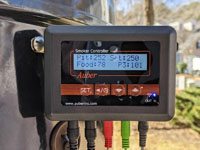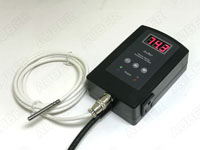Categories
- PID Controllers
- Auto gauges, EGT Boost
- Coffee Machine Kits
- Brew Equipment
- Power Regulators
- Powder Coating Equipment
- Powder Coating Ovens
- Smoker Controllers
- Humidity Controllers
- Plug-n-Play Controllers
- Thermometer, Process Meter
- Temperature Sensors
- SSRs & Contactors
- Timer, Counter, Tachometer
- Pressure Controller
- Controller for Coil Heater Enail
- Enclosures (Boxes)
- Switches
- Punch & Die for Control Panel
- DIN Rail Components
- Connectors
- Accessories
- Control Panels & DIY Kits
- Sous Vide Cooking
- Liquid Dispensing Machine
- Controller For Lab Research
- Silicone Tubing (Platinum Cured)
- Value Packs
- Scratch/Dent/Refurbished
- Services
- Specials ...
- Featured Products ...
- All Products ...
Featured [more]

WIFI BBQ Temp Control Kit For Regular Smoker, 3-Probe, 2nd Gen.
Save: $15.00 off
Automobile Gauge
1. Can the automobile gauge SYL-1813 work with more than one probe?
The gauge can only work with one probe at a time. But you may use a mechanical external switch to switch the sensors to make it work with more than one probe. If you are going to use different types of sensors for one gauge, e.g. EGT and MAP, it is not practical to switch from one measurement to the other while driving because you need about 20 to 40 seconds to do it. Here is what you need to do.
1) When measuring EGT, the 5V power supply line for MAP sensor needs to be disconnected.
2) You need about 10 to 15 seconds to change the settings from reading EGT to MAP.
2. Can I use VDO sensor for the automobile gauge?
The automobile gauge can only work with one kind of VDO sensor, which is VDO 150 °C sensor. When using with VDO sensor, it can only display the temperature when temp is within 50-150 °C range. The gauge will display EEEE when temperature is below 50 °C and above 150 °C. For a wider range, you need to use our Pt100 probe.
3. What is the difference between TC-KEGT and TC-KEGTS probes?
Both TC-KEGT and TC-KEGTS probes are thermocouple based temperature probes for EGT application. TC-KEGT as an exposed tip and TC-KEGTS has a sealed tip. The sensing element in type K thermocouple (inside of the probe) is sensitive and can be corrupted to sulfur content in the fuel. So for diesel engines or if your fuel has high sulfur content, the exposed tip probe (TC-KEGT) may not last long. The sealed tip probe (TC-KEGTS) can protect the sensing element from the outside exhaust gas, and it is more reliable. Exposed tip has faster response time, but not recommended for diesel engine. If you are critical about the response time (like a race car), TC-KEGT may be used.
Sealed tip (such as TC-KEGTS) has about 500 ms response delay and exposed tip (such as TC-KEGT) has about 250 ms response delay.


